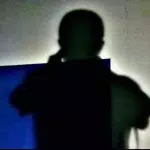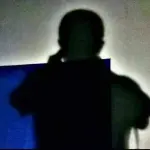I was watching The Eternaut—Argentina's grand sci-fi series. I'd made it to 8'30'' into Episode 2, and was deeply immersed in the slightly solemn, even womewhat somber atmosphere, when it suddenly hit me: it was snowing outside of my previous apartment!
The snow didn't catch my attention for long though, and I returned to seeing Juan Salvo (Ricardo Darín) in a homemade protective suit and gas mask opening a map of Vicente López under a pedestrian bridge, then heading into the nearby Bartolomé Mitre light rail station. He starts walking along the tracks toward the capital, CABA, determined to reach his ex-wife’s home and find his daughter.

Last year, I lived for half a year in an apartment near the station. It was right across the narrow street—Fernán Félix de Amador, which is named after a prominent Argentinian journalist. The station itself bears the name of Argentina’s sixth president (1862–1868), Bartolomé Mitre. It’s one of the endpoints of a 77-year-old light rail line. Hop on one of the blue-and-white trains, painted to match the national flag, and with a guitarist strumming folk songs or a rapper spitting fury in the carriage, you’ll gently sway along for half an hour or so until you arrive at Retiro, the main transportation hub of Buenos Aires. In The Eternaut Episode 2, Juan follows this very track, arrives not far from Florida station, and finds a train paralyzed on the rails and a crowd of survivors packed inside a car, sheltering themselves from the toxic snow.
From the other side of the Bartolomé Mitre station, if you walk up the fully enclosed pedestrian bridge over Maipú Avenue, you’ll reach another light rail station—Maipú—technically adjacent but not connected. This one marks the start of the Tren de la Costa, a scenic, touristic route that ends at Delta in the popular holiday town Tigre.
There's another light rail line connecting Tigre’s main station with Retiro in the capital. Later in Episode 1, a suicide squad sets off from May Camp by an old fuel-powered jeep from an abandoned garage along this very line, ramming through cars piled up along the Av. Gral. Paz, and breaks into the city to broadcast a signal calling for survivors to gather.
Av. Gral. Paz, with its dual-level road system, marks the boundary between the autonomous city of Buenos Aires (CABA) and the surrounding province of the same name. Buenos Aires Province, almost the size of Poland at 306,000 square kilometers, covers the most significant portion of the vast Pampas grasslands. In Season 1, most of the characters are trapped and fighting just outside the capital, in Vicente López—the first administrative district across the border and an integral part of the metro area. Based on the changes in scenery during Juan’s walk to find his daughter, it’s likely that the home of Favalli, the show’s second lead, is located in Olivos, a neighborhood in Vicente López. That also happens to be where I stayed during my time in Argentina.

After moving to Olivos, I took an evening walk one night and found myself in front of a sand-colored building with a Latin American colonial flair. A slightly blinding neon sign spelled out eight letters: CINE YORK. Across the street stood a statue of someone named Juan Carlos Altavista, who Google told me was a major figure in Argentine comedy. A plaque nearby described the building’s history: back in 1910, a charitable organization inside this very structure purchased film projection equipment and four fans, giving birth to a screening room called “Select.” It began operating as a cinema in the 1930s and was officially declared a municipal historic landmark in 1996.
Posters at the entrance announced two upcoming film series: one in memory of Argentine experimental cinema pioneer Narcisa Hirsch, who had passed away just two months prior, and another showcasing stories about Argentine musicians in film. Screenings were free— one only had to fill out a registration form on the cinema's website.

A woman standing at the entrance turned out to be Bea, head of social media for the cinema and its programs.
“As a cinephile and someone working in the industry, I think you’ve come to the right place,” she told me. “Our screening schedule is super active—after all, we were just named a UNESCO City of Film.”
“Wait—what? A UNESCO City of Film? Buenos Aires?” I asked, surprised.
“No, not Buenos Aires. Vicente López,” Bea replied.
To my astonishment, this veteran film fan had unknowingly been living in a UNESCO-designated City of Film all along. I quickly checked UNESCO’s official Creative Cities website, and sure enough: in October 2023, Vicente López was added to the network as an official City of Film. Among the other 25 cities with that title were obvious heavyweights like Cannes, Rome, Busan, Mumbai, Qingdao, Yamagata, Potsdam, and Wellington—places known either for their major film festivals or world-renowned studios.
A few days later, a colleague took me to the original site of Lumiton—the first film studio in Latin America—to meet Adriano Bruzzesse, director of the City of Film project and curator of its screenings. This significant landmark in Argentinian film history is also located in the Olivos neighborhood. The official website that updates Vicente López’s screenings is named after this studio: lumiton.ar. On the building’s now-black-painted exterior wall, bold letters read: LUMITON MUSEO DEL CINE | USINA AUDIOVISUAL (“Lumiton Film Museum | Audiovisual Factory”).

Adriano greeted us along with an assistant and led us on a well-practiced tour of the museum, introducing both the history of Lumiton and the City of Film initiative.
It all started with Susini, a technological and artistic polymath who, a century ago, led a group of radio enthusiasts to become some of the world’s first broadcasters. They went on to convert the world’s first radio station into a film studio: Lumiton. In 1933, Lumiton produced Los Tres Berretines, Argentina’s first sound film. Susini later directed La Chismosa (1938), the first Argentine film to participate in the Venice Film Festival, and then made Madama Lynch, the country's first musical. Eventually tiring of cinema, Susini returned to his roots in sound, becoming a voice therapist for well-known singers Carlos Gardel and Maria Callas.
As we toured the halls of honor and the vintage equipment displays, the assistant shared details not found on the website. Because Argentina had stayed out of the world wars, its film industry flourished in parallel with Hollywood’s Golden Age. When Lumiton launched in the 1930s, it was nicknamed “The House of Stars”—not metaphorically, but because movie stars actually lived on set. Since Olivos was far from central Buenos Aires, the public transport was still underdeveloped, and unions hadn’t yet secured work-hour protections, actors and crews had to stay on site for months until filming wrapped.
Today, the former studio turned museum still houses a small screening room with just over 30 seats. At 3 PM, a Chaplin silent film began to play, serving as film education for local residents. As the projectionist drew the curtains closed, we lowered our voices and stepped back outside.
Another arthouse cinema within four kilometers of my apartment is the Munro Cultural Center. While Lumiton was filming its first talkies in the 1930s, Munro was still a train station—an ideal outdoor location. It wasn’t until 1945 that the station was demolished and rebuilt as a single-screen theater. I’ve only been there once, when I finally caught a screening of E.T. It was a special session for local schoolchildren. When the curtain rose and the kids on screen began discovering the alien in the woods, I realized the entire film had been dubbed into Spanish.

On the Lumiton website, a full schedule of activities is published at the beginning of each month—usually 40 to 50 screenings, along with 3 or 4 workshops, all free of charge! All you have to do is reserve your spot. The selection mainly features Argentinian classics, but retrospectives on Hollywood legends, European auteurs, and Japanese masters are frequent too.
I have been puzzled by a question: with President Milei’s budget-slashing chainsaw cutting deeply into public spending on culture, how could the city sustain such a high volume of low-cost—even free—film screenings? Screening venues still need to pay for electricity and maintenance—did they not even pay licensing fees for the films?
Even my friends in the local film industry weren’t sure whether screening venues paid for film rights. But they pointed out that places like Lumiton or Sala Leopoldo Lugones in Teatro General San Martín function partly like archives and possess substantial in-house film collections. And even if public funding dries up, active civil society organizations and foundations often step in to fill the gap. All in all, this wealth of accessible cultural content makes it easy for Argentinians to receive visual arts education.
It’s probably no coincidence that El Eternauta: The Series chose Vicente López as a primary shooting location. The story required tension-filled scenes of constant escape and rescue across urban and suburban landscapes. But perhaps the decision was also influenced by behind-the-scenes support from the City of Film initiative—like access to gear and tax breaks. I thought back to a Chinese-Argentine friend, Lei Qi, whom I met during my stay in Argentina last year. He once shot some commercials in Vicente López and used the decent pay to fund his personal passion project: a documentary tribute to Argentine football. Seeing the Chinese youth rescued by Juan and his ex-wife Elena in the series, I couldn’t help but notice how much he resembled the filmmakers Lei Qi.

















































View replies 1